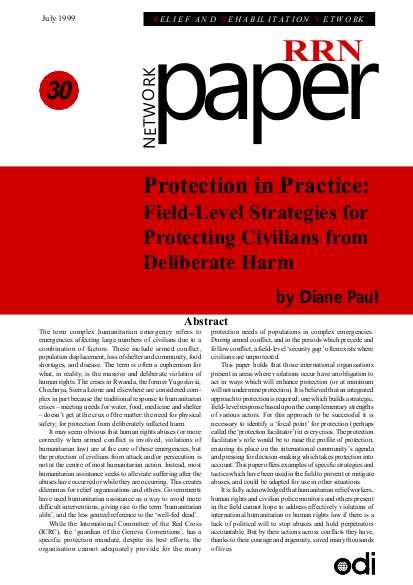
The term complex humanitarian emergency refers to emergencies affecting large numbers of civilians due to a combination of factors. These include armed conflict, population displacement, loss of shelter and community, food shortages, and disease. The term is often a euphemism for what, in reality, is the massive and deliberate violation of human rights. The crises in Rwanda, the former Yugoslavia, Chechnya, Sierra Leone and elsewhere are considered complex in part because the traditional response to humanitarian crises – meeting needs for water, food, medicine and shelter – doesn’t get at the crux of the matter: the need for physical safety; for protection from deliberately inflicted harm.
It may seem obvious that human rights abuses (or more correctly when armed conflict is involved, violations of humanitarian law) are at the core of these emergencies, but the protection of civilians from attack and/or persecution is not at the centre of most humanitarian action. Instead, most humanitarian assistance seeks to alleviate suffering after the abuses have occurred or while they are occurring. This creates dilemmas for relief organisations and others. Governments have used humanitarian assistance as a way to avoid more difficult interventions, giving rise to the term ‘humanitarian alibi’, and the less genteel reference to the ‘well-fed dead’.
While the International Committee of the Red Cross (ICRC), the ‘guardian of the Geneva Conventions’, has a specific protection mandate, despite its best efforts, the organisation cannot adequately provide for the many protection needs of populations in complex emergencies. During armed conflict, and in the periods which precede and follow conflict, a field-level ‘security gap’ often exists where civilians are unprotected.
This paper holds that those international organisations present in areas where violations occur have an obligation to act in ways which will enhance protection (or at minimum will not undermine protection). It is believed that an integrated approach to protection is required; one which builds a strategic, field-level response based upon the complementary strengths of various actors. For this approach to be successful it is necessary to identify a ‘focal point’ for protection (perhaps called the ‘protection facilitator’) in every crisis. The protection facilitator’s role would be to raise the profile of protection, ensuring its place on the international community’s agenda and pressing for decision-making which takes protection into account. This paper offers examples of specific strategies and tactics which have been used in the field to prevent or mitigate abuses, and could be adapted for use in other situations.
It is fully acknowledged that humanitarian relief workers, human rights and civilian police monitors and others present in the field cannot hope to address effectively violations of international humanitarian or human rights law if there is a lack of political will to stop abuses and hold perpetrators accountable. But by their actions across conflicts they have, thanks to their courage and ingenuity, saved many thousands of lives.